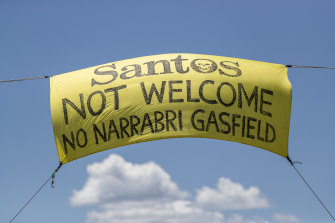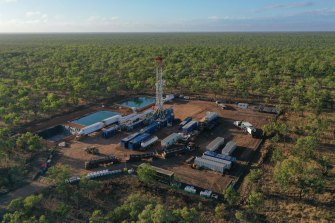
The gas industry’s expansion sets Australia at odds with the global shift towards renewables. Earlier this year the International Energy Agency released analysis that found the global route to net zero emissions was “narrow and extremely challenging”, and that no new fossil fuel projects should be approved.
The federal priorities include the development of the Port Kembla gas terminal in NSW, and envisages opening up new gas basins. The Beetaloo Basin in the Northern Territory should be brought into production by 2025, Narrabri in NSW from 2026 and Queensland’s Galilee and North Bowen basins in production by 2028, the plan says.

An alliance of residents, local businesses, and environmentalists have failed to stop Santos’ coal seam gas plans in New South Wales. Credit:Getty Images AsiaPac
The plan also identifies potential offshore supply from the Bass, Otway and Gippsland basins. But the majority of new southern fields within these basins are in the ‘discovery’ phase, and it is unclear when production might start.
Protect Country Alliance spokesperson Graeme Sawyer said the fracking industry in the Northern Territory, still in an exploratory phase, was being supported by “corporate welfare”.
“The Morrison government would be better off giving taxpayer money to just about any other industry if it wanted to seriously stimulate the economy,” Mr Sawyer said.
Demand for natural gas remains strong in Australia and Asia to replace coal, providing back up for renewables and to underpin industrial growth, said Andrew McConville, the chief executive of gas industry body APPEA.
“The National Gas Investment Plan confirms the importance of investment to bring gas to the market. Our members have announced more than $27 billion in new investment this year alone and analysis from EY suggests that could reach $350 billion under the right investment settings,” Mr McConville said.
The Climate Council’s head of research, Dr Simon Bradshaw, described the plan as a “disaster”. “What part of gas is a polluting fossil fuel does this government not understand? The science is very clear: to avoid a climate catastrophe, fossil fuels must stay in the ground,” he said.

The Beetaloo basin gas project in the Northern Territory has attracted protests and now a climate suit against federal Resources Minister Keith Pitt. Credit:.
Loading
The plan underlines the government’s interest in developing its so-called “clean” hydrogen industry, noting hydrogen may be produced using gas and that carbon emissions could be stored using the controversial practice of carbon capture and storage. This would not be classed as “green” hydrogen, which is produced with renewable energy.
Not everyone is convinced Australia faces a looming gas shortage. Environment Victoria analysis found there is enough gas supply capacity in Victoria until 2027.
Over the following three years there is a shortfall of between 26 petajoules (PJ) and 85 PJ, but the adoption of gas-demand reduction measures, like increasing energy efficiency and electrification, eliminates the forecast shortfall.









 Add Category
Add Category